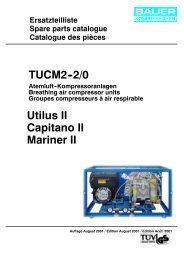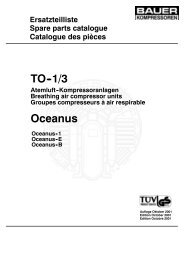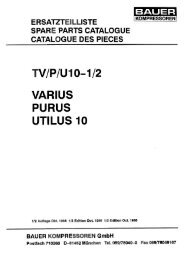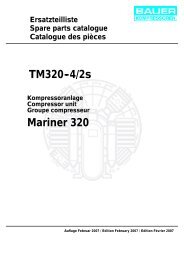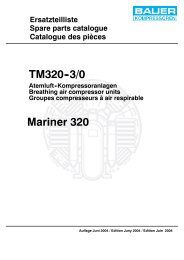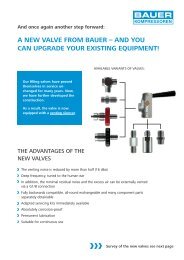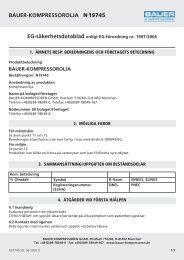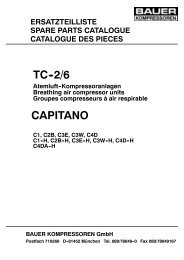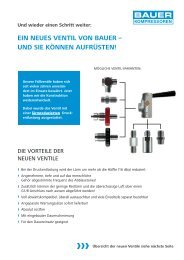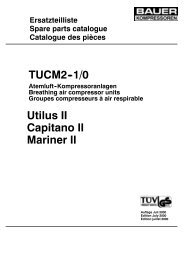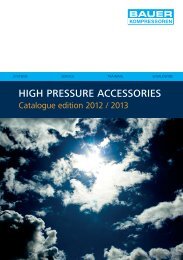Operator's Manual High Pressure Breathing Air Compressors
Operator's Manual High Pressure Breathing Air Compressors
Operator's Manual High Pressure Breathing Air Compressors
Create successful ePaper yourself
Turn your PDF publications into a flip-book with our unique Google optimized e-Paper software.
Operator’s <strong>Manual</strong><br />
through, for example, these getting caught or being pulled<br />
into the equipment.<br />
• As far as necessary or according to regulations, use personal<br />
protective equipment.<br />
• Observe all safety and danger notices on the machine / unit.<br />
• Keep all safety and danger notices on the machine / unit<br />
complete and in readable condition.<br />
• If there are any modifications to the machine / unit or operating<br />
conditions which may affect safety, stop the machine /<br />
unit immediately and inform the department / person responsible<br />
of the fault.<br />
• No modifications may be made to the machine / unit which<br />
could impair safety without first obtaining permission from<br />
the suppliers. This is also the case with regard to installation<br />
and adjustment of safety devices and valves as well as<br />
welding of piping and reservoirs.<br />
• Spare parts must always comply with the technical requirements<br />
specified by the manufacturer. This is always guaranteed<br />
with original spare parts.<br />
• Do not carry out programme changes (software) to the programmable<br />
control system.<br />
• Piping must be thoroughly checked (pressure and visual inspection)<br />
by the operator at appropriate time intervals, even<br />
if no safety related faults have been noticed.<br />
• Intervals stipulated or given in the instruction manual for recurring<br />
checks / inspections must be adhered to.<br />
• It is absolutely essential that the workplace is appropriately<br />
equipped for maintenance measures.<br />
• Make sure location and operation of fire extinguishers is<br />
known.<br />
• Pay attention to fire warning and fire fighting procedures.<br />
Qualifications, fundamental duties<br />
• Work on / with the machine / unit may only be carried out by<br />
reliable personnel. Observe the legal minimum age permissible.<br />
• Only employ trained personnel, clearly establish responsibility<br />
of personnel for operation, maintenance and repairwork.<br />
• Ensure that only trained personnel work with the machine.<br />
• Establish the responsibilities of the machine operator and<br />
establish a procedure for him to inform a third person of unfavourable<br />
safety conditions.<br />
• People who are being trained or introduced to the job should<br />
only be allowed to work with the machine / unit under constant<br />
supervision of an experienced person.<br />
• Work on the electrical equipment of the machine / unit may<br />
only be carried out by a qualified electrician or by an instructed<br />
person under the direction and supervision of a<br />
qualified electrician according to electrotechnical regulations.<br />
• Work on gas equipment may only be carried out by qualified<br />
personnel.<br />
Safety notices for operation<br />
• Do not carry out any work if safety is questionable.<br />
• Meet all requirements demanding that the machine / unit is<br />
only operated in safe and good working order. Only operate<br />
the machine if all protective and safety equipment, e.g. all<br />
detachable protective equipment, emergency shut--down<br />
devices, soundproofing is provided and in good working<br />
order.<br />
• At least once every day, check the machine / unit externally<br />
for damage and faults. Inform the department / person responsible<br />
immediately if anything is not as is should be (including<br />
operation). If necessary, shut the machine down immediately<br />
and make it safe.<br />
• If there are any malfunctions, shut the machine / unit down<br />
immediately and make it safe. Correct faults immediately (or<br />
have them corrected).<br />
• Observe switching on and off processes and monitoring indications<br />
according to the instruction manual.<br />
• Before switching on / starting up the machine / unit, ensure<br />
that no one can be put at risk through running the machine<br />
/ unit.<br />
• Carry out the setting, maintenance and inspection processes<br />
at the intervals specified in the instruction manual,<br />
including replacement of parts / equipment. This work may<br />
only be carried out by qualified personnel.<br />
• Before carrying out any exceptional work or repairwork, operating<br />
personnel should be informed. Call the supervisor.<br />
• For all work concerning operation, change in production,<br />
conversion or regulating of the machine / unit and its safety<br />
measures such as inspection, maintenance and repairwork,<br />
observe the switching on and off processes in the instruction<br />
manual and the notices for maintenance work.<br />
• Clear and make the maintenance area safe as far as<br />
necessary.<br />
• If the machine / unit is completely switched off for maintenance<br />
and repairwork, ensure that it is protected from unexpected<br />
start--up. Turn off main control device and remove<br />
the key and / or display a warning sign on the main switch.<br />
• When replacing individual parts and larger assembly<br />
groups, they must be carefully fastened to the lifting device<br />
so that there is no risk of danger. Use only suitable and<br />
technically perfect lifting devices and equipment with sufficient<br />
lifting power and strength. Do not linger or work under<br />
suspended loads.<br />
• Only entrust an experienced person with the fixing of loads<br />
and guiding of crane drivers. The person guiding must remain<br />
within sight or in contact with the operator.<br />
• For assembly work above body height, use appropriate<br />
safety approved equipment, e.g. ladders and platforms. Do<br />
not climb on machine parts. For maintenance work at high<br />
levels, wear a safety harness.<br />
• Clean oil, fuel or care products from the machine, in particular<br />
the connections and screw joints, before carrying out<br />
maintenance / repairwork. Do not use aggressive cleaning<br />
fluid. Use a fibre--free cleaning cloth.<br />
• Before cleaning the machine with water or jet of steam (high<br />
pressure cleaner) or detergent, cover / seal all openings<br />
which for safety and/or operating reasons no water / steam<br />
/ detergent may penetrate. Electric motor and switch cabinets<br />
are particularly at risk.<br />
• When cleaning the operating room, ensure that the temperature<br />
sensors of the fire alarm and sprinkler system do<br />
not come into contact with hot cleaning fluid, in order to<br />
avoid triggering the sprinkler system.<br />
11



